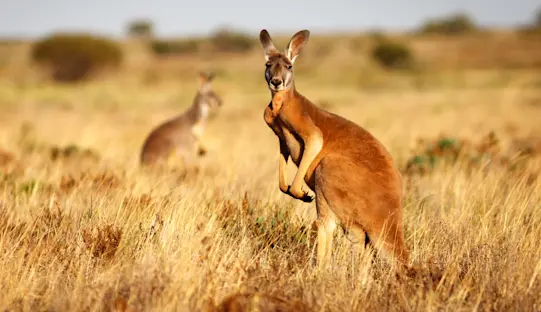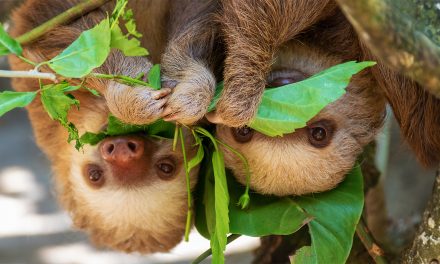Encountering sea turtles in their natural habitats is an extraordinary privilege. These graceful marine reptiles—currently classified as endangered—face threats ranging from the overharvesting of their eggs and hunting to entanglement in fishing nets, ocean plastic pollution, and the loss of crucial nesting habitats. Primarily inhabiting tropical and subtropical waters around the globe, these turtles offer travelers rare moments of connection during expeditions such as Galapagos Discovery: The Nat Hab Experience, Sea Turtles & Wildlife of Northern Costa Rica and our Ultimate Australia Safari, highlighting the importance of conservation travel in protecting these ancient mariners.
Here are 13 sea turtle facts to know before you go!
1. How big are sea turtles?
Green sea turtles (Chelonia mydas) are the largest hard-shelled marine turtles in the world, growing up to 5 feet and weighing as much as 500 pounds. But leatherbacks (Dermochelys coriacea) outsize them all. They are the world’s biggest sea turtles, reaching lengths over 6 feet and weighing up to 2,000 pounds.
Leatherbacks are the only sea turtle species without a hard, bony shell. Instead, their carapace is:
-
Leathery and flexible, composed of tough, oily skin overlaying a layer of cartilage and connective tissue.
-
Ridge-lined, with seven longitudinal keels that give it a distinct, hydrodynamic shape.
-
Covered in tiny osteoderms (bone-like structures), but these don’t form a solid shell like in green, hawksbill or loggerhead turtles.
2. What do sea turtles eat?
Adult green sea turtles are mostly herbivores, grazing on seagrasses and algae. Their jaws are finely serrated—like the edge of a saw—which helps them tear and chew tough plant material. Juvenile greens, while still developing, are more omnivorous and may eat jellyfish, crabs and sponges.
In contrast, leatherback turtles specialize in soft-bodied prey, particularly jellyfish. They have delicate, scissor-like jaws that would be damaged by anything harder than their gelatinous meals. Inside their mouths and throats are backward-pointing spines called papillae, which help trap slippery jellyfish and prevent them from escaping once swallowed.
3. A key link in the marine food chain
Sea turtles play vital ecological roles. Greens help maintain healthy seagrass beds, and leatherbacks control jellyfish populations. Both species serve as prey for sharks and other large predators, making them an integral part of ocean ecosystems.
4. Why “green”? Why “leatherback”?
Green sea turtles are named not for their shell color—which is typically brown or olive—but for the greenish hue of the fat beneath their skin, colored by their vegetarian diet. Leatherbacks, by contrast, get their name from their unique shell: it’s not hard but rubbery and ridged, with a leathery texture unlike any other sea turtle.
5. Older than dinosaurs
Sea turtles are one of the most ancient vertebrate groups alive today. Their ancestors took to the seas more than 150 million years ago, well before the rise and fall of dinosaurs.
Leatherbacks, in particular, belong to an even more primitive lineage distinct from all other living sea turtles. They are the sole surviving members of the family Dermochelyidae, which split off from other sea turtles over 100 million years ago.
6. No place to hide
Unlike land turtles, sea turtles—including both green and leatherback species—cannot retract their heads or limbs into their shells. Their streamlined bodies are designed for life at sea.
7. Speed in the sea
Green sea turtles can swim at speeds up to 35 mph in short bursts using their powerful front flippers. Leatherbacks, though less speedy, are long-distance champions. They can travel more than 10,000 miles a year during migrations across entire ocean basins.
8. Sun seekers and deep divers
Green sea turtles are occasionally seen basking on beaches—something rare among marine turtles. Leatherbacks, in contrast, are deep divers. They can plunge more than 4,000 feet in search of jellyfish, making them the deepest-diving reptiles on Earth!
9. Where do sea turtles live?
Green sea turtles are commonly found in tropical and subtropical waters inside reefs, bays and inlets. Leatherbacks have the widest range of any sea turtle species, occurring in both warm and cold oceans—from the tropics to as far north as Alaska. On Nat Hab’s Northern Costa Rica adventure, travelers will witness the arribada (Spanish for “arrival”), a mass nesting event when thousands of leatherback and olive ridley sea turtles come ashore to lay their eggs.
10. Baby sea turtles face a perilous start
Female turtles dig nests in the sand to lay their eggs.
- Green sea turtles produce more eggs per nest on average (100–200 eggs) and often have a higher proportion of viable eggs.
-
Leatherbacks lay 80–100 eggs per clutch (20% aren’t viable), though they nest more frequently within a single season.
Hatchlings emerge at night to avoid predators, but only a few survive the dangerous crawl to the sea—and fewer still reach adulthood.
11. Do sea turtles cry?
They do—but not from emotion. Sea turtles excrete excess salt through special glands near their eyes, which can look like tears.
12. Hot sand, girl turtles
Temperature determines the sex of sea turtle hatchlings. Warmer sands tend to produce females, while cooler sands yield more males. This phenomenon affects both green and leatherback turtles and is a growing concern as global temperatures rise.
13. How WWF helps protect sea turtles
WWF works globally to safeguard sea turtles by protecting nesting beaches, reducing bycatch, encouraging turtle-friendly fisheries, fighting illegal trade in turtle products and supporting community-based ecotourism. These efforts give travelers a chance to contribute to conservation just by choosing the right kind of wildlife experience.



































